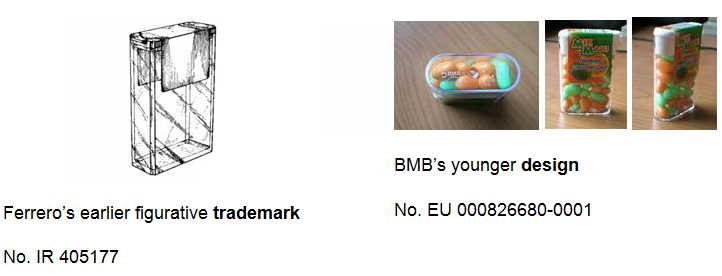


ECJ landmark case: Successful invalidity proceedings against an EU design based on an earlier trademark
ECJ landmark case: Successful invalidity proceedings against an EU design based on an earlier trademark
With its decision dated 6 March 2019, the European Court of Justice (ECJ) confirmed a decision of the European General Court (GC) concerning invalidity proceedings between Ferrero SpA (Ferrero) and BMB sp. z o.o. (BMB) regarding the following opposing IP rights.
In particular, the ECJ upheld the GC’s finding that there is a likelihood of confusion between the earlier trademark and the younger design. With the present decision, a dispute which had been going on for almost ten years has now come to an end.
I. Background of the case
On 15 November 2007, the Polish company BMB filed the EU design application no. 000826680-0001 showing the shape of a container for little sweets. The filed layouts also show the content of this container, namely green and orange candies. In addition, the container bears a colored label on which the verbal element “MIK MAKI LEMONOWO POMARAŃCZOWE” is displayed. The design was applied in Locarno Class 09.03 – containers, comfit boxes. The design was registered on the filing date.
The popular Italian company Ferrero filed an application for a declaration of invalidity of the registered design before the European Union Intellectual Property Office (EUIPO) on 11 July 2011. In support of its application, Ferrero invoked three earlier rights, including International Registration no. 405177 of a trademark, registered on 12 March 1974, with effect in several EU countries. The EUIPO granted Ferrero’s application for a declaration of invalidity on 25 April 2012 considering particularly, due to the similarity of the opposing signs and the identity of the goods, that there was a likelihood of confusion on the part of the relevant public.
Also at the appeal stage, the invalidity of the contested design was upheld by the EUIPO Third Board of Appeal with its decision dated 25 April 2012.
BMB went further and brought an action for annulment of the Board of Appeal’s decision by application lodged at the Registry of the General Court on 24 November 2015. It raised different pleas in law in support of its action and, in particular, that the Board of Appeal had erred in finding that there was a likelihood of confusion between the earlier trademark and the younger design. However, the action was dismissed by the GC on 3 October 2017.
II. BMB’s appeal to the European Court of Justice
The owner of the contested design made a final attempt and went to the ECJ, appealing the decision of the GC. In its appeal dated 10 December 2017, BMB put forward the following grounds:
First, BMB claimed that the GC incorrectly classified the earlier International Registration as a 3D mark, whereas the mark is registered as figurative mark. That error allegedly led the GC to compare the contested design to a mark which is not the earlier International Registration but rather a 3D mark assumed to be similar to that registration.
Second, BMB argued that the GC was incorrect to refuse to take into consideration the fact that the contested design, unlike the earlier International Registration, is represented filled with sweets.
Third, BMB claimed that the GC failed to correctly assess the significance of the differences between the earlier International Registration and the contested design, despite having acknowledged those differences, namely the rounded edges and the label of the contested design, and failed to take into account all of the dominant and distinctive elements of the signs at issue.
And fourth, BMB basically criticized the GC’s finding that it was not necessary, in determining the likelihood of confusion in the case, to take national case-law (in particular, a decision of the French tribunal de grande instance de Paris of 6 November 2009, in which it was confirmed that a sign with the same characteristics as the contested design does not infringe the earlier International Registration) into account.
III. Ruling by the European Court of Justice
The ECJ rejected all four main arguments brought forward in BMB’s grounds of appeal. In particular, the ECJ considered the first two arguments to be unfounded and the third argument to be inadmissible. The fourth argument was rejected as such, in particular, since the ECJ is not bound by national case-law.
As a result, the ECJ dismissed the appeal in its entirety.
IV. Remarks
The trademark and design battle between Ferrero and BMB was fought through all EU instances. BMB lost all of them. The decision that BMB’s design registration is declared invalid has now become final, as there are no further appeals possible for BMB.
Considering and comparing the opposing signs as such, this result is actually not surprising. From a trademark and design expert’s point of view, it would have been unusual not to consider them dissimilar. This decision and the whole proceedings through all instances are however spectacular, since it is very rare that invalidity proceedings between different IP rights – trademarks vs. designs – are decided upon by the highest EU courts.
For more information, please find the full decision here: http://curia.europa.eu/juris/document/document.jsf?text&docid=195183&pageIndex=0&doclang=EN&mode=req&dir&occ=first&part=1&cid=5283.
Related
- "Neuschwanstein" is not a trademark!
- 14 June 2013: Munich Patent Law Conference - Calculating Damages in Patent Infringement Cases
- 15 Top Brands - Interactive Brand Rating - Years 2000 - 2018
- 2014: Statistics for Community Trademarks
- 27 June 2014: Munich Patent Law Conference – Burden of Pleading and Proof in Patent Infringement Cases
- 3D-Trademark Protection for layout of Apple Stores
- 40th Anniversary of the European Patent Convention (EPC)
- A backpack shape as a 3D trademark – a BoA decision of the EUIPO
- A case of „Bounty“ hunting in Germany
- A new report on the economic impact of counterfeit trade published by OECD and EUIPO
